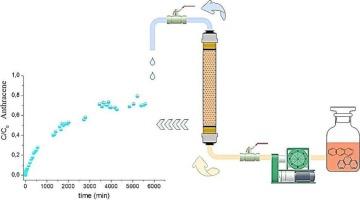利用新型表面活性剂-粘土杂化材料去除多环芳烃的研究
IF 5.8
2区 地球科学
Q2 CHEMISTRY, PHYSICAL
引用次数: 0
摘要
为了满足日益严格的法律法规,废水处理技术需要改进,适应或新的发展,以去除有毒化合物。本文通过静态和动态实验分析了两种低成本有机粘土(H5-Mt/TPODAC-1.5和Mt./TPODAC-1.5)作为吸附剂对水中多芳烃(PAHs)的去除效果。以蒽(ANT)和16种多环芳烃(PAHs)为主要吸附源,研究了两种水溶液的吸附动力学特征、最佳吸附剂用量和竞争效应。这两种有机粘土对高分子量的多环芳烃(PAHs)都有很高的去除能力。H5-Mt/TPODAC-1.5的最大吸附量为2700 μg−1,Mt./TPODAC-1.5的最大吸附量为3300 μg−1。选择最有效的有机粘土在固定床柱上进行进一步评估,以评估操作流速、床长和初始浓度对ANT去除的影响。分析了有效床容和总床容、传质区、床断点时间和去除等效率参数。采用8.5 cm长填充有机粘土的固定床柱进行了22 h的动态研究,结果表明,当料液中初始ANT浓度为41 μg L−1时,ANT的剩余浓度为4 μg L−1。本文章由计算机程序翻译,如有差异,请以英文原文为准。

Insight into polycyclic aromatic hydrocarbons removal using novel surfactant-clay hybrid material
In order to satisfy increasingly strict legal regulations, wastewater treatment technologies require improvements, adaptations, or new developments for the removal of toxic compounds. This work analyses the removal of polyaromatic hydrocarbons (PAHs) from water using two low-cost organoclays as alternative sorbents (H5-Mt/TPODAC-1.5 and Mt./TPODAC-1.5) through static and dynamic experiments. The kinetics features, optimal sorbent dosage, and competitive effects were study by batch adsorption tests using two aqueous solutions spiked with anthracene (ANT) and sixteen PAHs, respectively. Both organoclays showed a high removal capacities for high molecular weight PAHs, which are classified as carcinogenic. The maximum adsorption capacity for ANT was estimated to be 2700 μg g−1 for H5-Mt/TPODAC-1.5 and 3300 μg g−1 for Mt./TPODAC-1.5. The most efficient organoclay was selected for further evaluation in fixed bed columns to assess the influence of operating flow rate, bed length, and initial concentration on the ANT removal. Efficiency parameters such as useful and total bed capacity, mass transfer zone, bed breakpoint time and removal were analysed. Dynamic study using a fixed bed column of 8.5 cm length filled with organoclay conducted over 22 h showed that the remaining concentration of ANT was <4 μg L−1 when the initial ANT concentration in the feed solution was 41 μg L−1.
求助全文
通过发布文献求助,成功后即可免费获取论文全文。
去求助
来源期刊

Applied Clay Science
地学-矿物学
CiteScore
10.30
自引率
10.70%
发文量
289
审稿时长
39 days
期刊介绍:
Applied Clay Science aims to be an international journal attracting high quality scientific papers on clays and clay minerals, including research papers, reviews, and technical notes. The journal covers typical subjects of Fundamental and Applied Clay Science such as:
• Synthesis and purification
• Structural, crystallographic and mineralogical properties of clays and clay minerals
• Thermal properties of clays and clay minerals
• Physico-chemical properties including i) surface and interface properties; ii) thermodynamic properties; iii) mechanical properties
• Interaction with water, with polar and apolar molecules
• Colloidal properties and rheology
• Adsorption, Intercalation, Ionic exchange
• Genesis and deposits of clay minerals
• Geology and geochemistry of clays
• Modification of clays and clay minerals properties by thermal and physical treatments
• Modification by chemical treatments with organic and inorganic molecules(organoclays, pillared clays)
• Modification by biological microorganisms. etc...
 求助内容:
求助内容: 应助结果提醒方式:
应助结果提醒方式:


